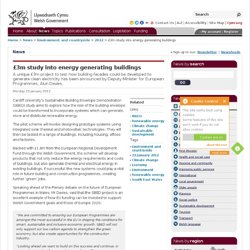

US tops global clean energy investment rankings. 12 April 2012Last updated at 04:11 ET By Mark Kinver Environment reporter, BBC News Global solar generation capacity increased by almost 30 gigawatts in 2011 The US has regained top spot from China as the biggest investor in clean energy in 2011, according to global rankings.

The table, published in a report by the Pew Charitable Trusts, showed that US invested more than $48bn (£30bn) in the sector, up from $34bn in 2010. China slipped to second place, the authors reported, with investment only increasing by $0.5bn to $45.5bn. Globally, overall financial backing in clean energy technologies hit a record $263bn, up 6.5% from 2010 levels. The report, Who is Winning the Clean Energy Race, showed that G20 nations accounted for 95% of the investment in the sector (which does not include nuclear power). The data, compiled by Bloomberg New Energy Finance, ranked the UK as seventh in the world, with $9.4bn of investment in 2011. "We now have 565GW of installed (generation) capacity around the world.
300 new jobs for Sharp's solar panel factory at Wrexham. Written ministerial statement by Edward Davey on reforming the Feed-in Tariffs (FITs) scheme. This Government is committed to promoting decentralised energy and the take-up of small-scale low-carbon technologies by the public and by communities.

The Feed-in Tariffs (FITs) scheme is an important instrument in meeting that commitment, but it needs to be reformed as we want as many people as possible to be able to benefit from the scheme. For too long it has been limited to the lucky few. So today I am publishing a series of documents which mark a crucial turning point for the FITs scheme. Taken as a whole, this reform package will put the scheme on a predictable, certain and sustainable footing for consumers, and for the businesses delivering these exciting renewable technologies. But that is by no means the end of the story on FITs.
The documents we are publishing today are as follows:- (i) Government response to the consultation on FITs for solar PV. We are now also announcing the details of the new energy efficiency requirement, and of the new multi-installation tariff rates. £3m study into energy generating buildings. Cardiff University’s Sustainable Building Envelope Demonstration (SBED) study aims to explore how the role of the building envelope could be transformed to incorporate systems which can generate, store and distribute renewable energy.

The pilot scheme will involve designing prototype systems using integrated solar thermal and photovoltaic technologies. They will then be tested in a range of buildings, including housing, offices and factories. Backed with £1.8m from the European Regional Development Fund through the Welsh Government, the scheme will develop products that not only reduce the energy requirements and costs of buildings, but also generate thermal and electrical energy in existing buildings.
If successful, the new systems could play a vital role in future building and construction programmes, creating further ‘green’ jobs. Phil Jones, Chair Low Carbon Research Institute, Cardiff University, said: Publications Bookshop. ETI invests £8m in evolution of UK’s electricity distribution networks. Two £4m projects have been launched by the Energy Technologies Institute (ETI) which will reduce the impact of faults on electricity distribution networks, helping the growth and increased flexibility of distribution systems, with more low carbon electricity generation installed in the distribution system.

They will also help minimise the costs of upgrading the UK’s electricity distribution network over the next 20 to 30 years. Each project will develop and demonstrate a fault current limiter device, which will reduce the damaging currents resulting from network faults and increase electricity network reliability for the future. The two projects, part of the ETI’s Energy Storage and Distribution Programme, will accelerate the development and demonstration of two of the most promising fault current limiter technologies from around the world. One project will design, develop and demonstrate a Pre-saturated Core Fault Current Limiter. E.ON will act as technical consultants on both projects.
Solar.